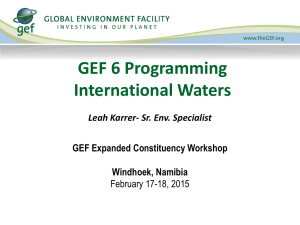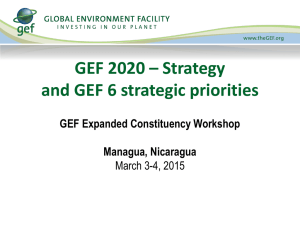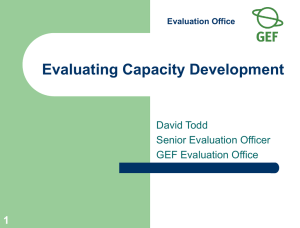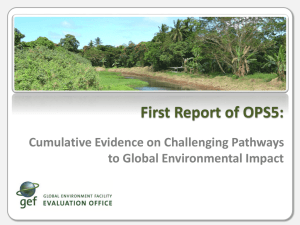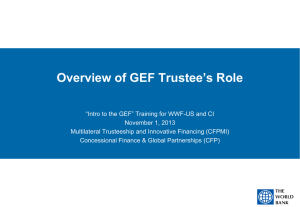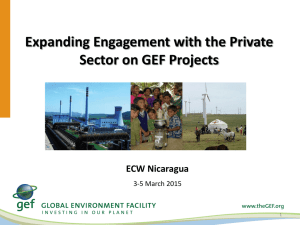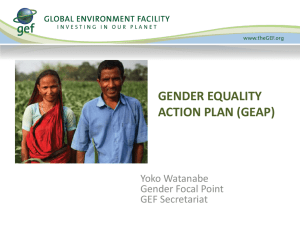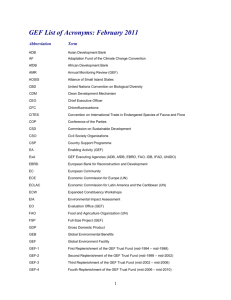PROJECT IDENTIFICATION FORM (PIF)
advertisement
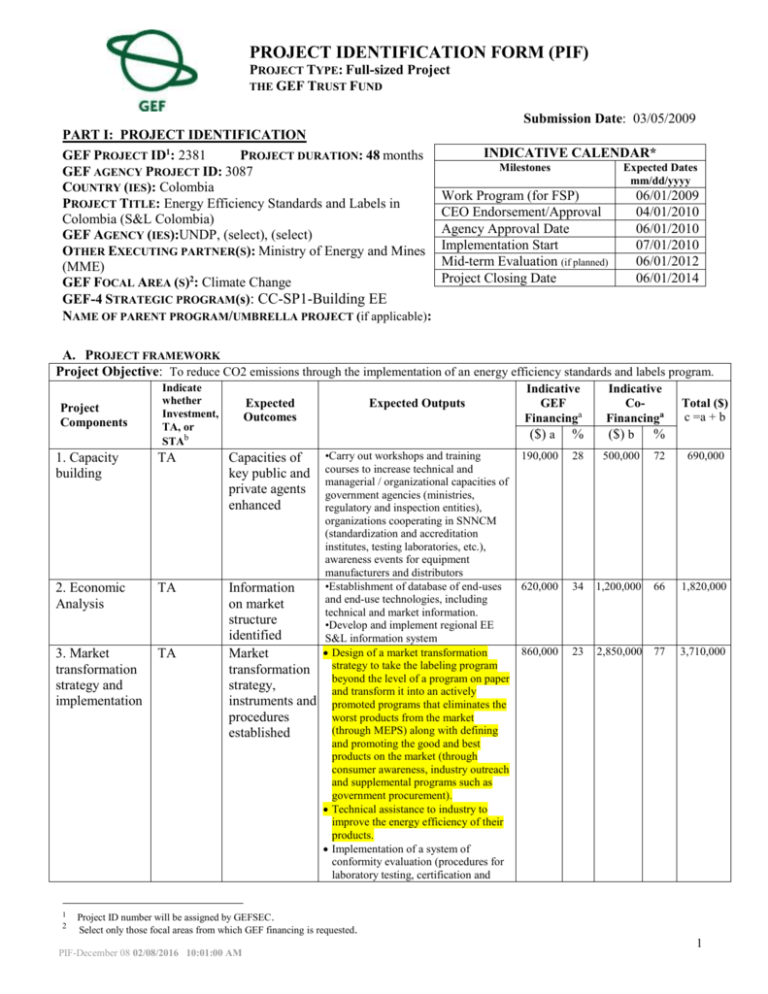
PROJECT IDENTIFICATION FORM (PIF) PROJECT TYPE: Full-sized Project THE GEF TRUST FUND Submission Date: 03/05/2009 PART I: PROJECT IDENTIFICATION GEF PROJECT ID1: 2381 PROJECT DURATION: 48 months GEF AGENCY PROJECT ID: 3087 COUNTRY (IES): Colombia PROJECT TITLE: Energy Efficiency Standards and Labels in Colombia (S&L Colombia) GEF AGENCY (IES):UNDP, (select), (select) OTHER EXECUTING PARTNER(S): Ministry of Energy and Mines (MME) GEF FOCAL AREA (S)2: Climate Change GEF-4 STRATEGIC PROGRAM(s): CC-SP1-Building EE NAME OF PARENT PROGRAM/UMBRELLA PROJECT (if applicable): INDICATIVE CALENDAR* Milestones Expected Dates mm/dd/yyyy Work Program (for FSP) CEO Endorsement/Approval Agency Approval Date Implementation Start Mid-term Evaluation (if planned) Project Closing Date 06/01/2009 04/01/2010 06/01/2010 07/01/2010 06/01/2012 06/01/2014 A. PROJECT FRAMEWORK Project Objective: To reduce CO2 emissions through the implementation of an energy efficiency standards and labels program. Project Components Indicate whether Investment, TA, or STAb Expected Outcomes Expected Outputs •Carry out workshops and training courses to increase technical and managerial / organizational capacities of government agencies (ministries, regulatory and inspection entities), organizations cooperating in SNNCM (standardization and accreditation institutes, testing laboratories, etc.), awareness events for equipment manufacturers and distributors •Establishment of database of end-uses and end-use technologies, including technical and market information. •Develop and implement regional EE S&L information system Design of a market transformation strategy to take the labeling program beyond the level of a program on paper and transform it into an actively promoted programs that eliminates the worst products from the market (through MEPS) along with defining and promoting the good and best products on the market (through consumer awareness, industry outreach and supplemental programs such as government procurement). Technical assistance to industry to improve the energy efficiency of their products. Implementation of a system of conformity evaluation (procedures for laboratory testing, certification and 1. Capacity building TA Capacities of key public and private agents enhanced 2. Economic Analysis TA 3. Market transformation strategy and implementation TA Information on market structure identified Market transformation strategy, instruments and procedures established 1 2 Indicative GEF Financinga ($) a % Indicative CoFinancinga ($) b % 190,000 28 500,000 72 690,000 620,000 34 1,200,000 66 1,820,000 860,000 23 2,850,000 77 3,710,000 Total ($) c =a + b Project ID number will be assigned by GEFSEC . Select only those focal areas from which GEF financing is requested. PIF-December 08 02/08/2016 10:01:00 AM 1 4. Legal and Regulatory Framework TA Legal framework for EE S&L strengthened and a resolution of differences in opinion among stakeholders and decision makers on key aspects of implementation 5. Consumer awareness & Industry Outreach TA 6. Monitoring and evaluation TA Consumer & Industry communication strategy developed Project and EE S&L Program M&E carried out 7. Project management accreditation). This will be achieved through assistance to and capacity development of test labs, certification and accreditation bodies. The task does not only focus on the narrower area of “normas” or test procedures. Coordinate with national EE S&L programs of other countries of the region 130,000 Workshops and training sessions to demonstrate to stakeholders and decision makers the costs and benefits of alternative regulatory strategies (e.g., voluntary versus mandatory, step-wise application or not; supplementation with MEPS or not); Technical Committee organization and convening to elaborate draft regulations with the help of international experts but in the context of a locally facilitated discussion with all perspectives participating and a goal of driving to consensus A series of meetings to MME and UPME high level executives to propose regulatory alternatives based on the basic consensus achieved in the above task at the working level. The existing Interministeral Committee on Rational Use of Energy could be involved. Elaboration of final regulations to be endorsed by Minister (and/or President). •Consumer information campaigns 410,000 •Training of sales personnel •Recruitment of voluntary participation by industry in labeling as well as industry-funded promotion in the mandatory phase •Implement monitoring and evaluation 60,000 work plan to comply with GEF/UNDP procedures. •Collect, prepare and disseminate lessons learned to the extent required by GEF/UNDP procedures 230,000 A 2,500,000 Total project costs 16 700,000 84 830,000 23 1,400,000 77 1,810,000 80 15,000 20 75,000 22 835,000 78 1,065,000 B 7,500,000 10,000,000 a List the $ by project components. The percentage is the share of GEF and Co-financing respectively of the total amount for the component. b TA = Technical Assistance; STA = Scientific & Technical Analysis. B. INDICATIVE CO-FINANCING FOR THE PROJECT BY SOURCE and by NAME (in parenthesis) if available, ($) Sources of Co-financing Project Government Contribution Project Government Contribution GEF Agency(ies) Private Sector Private Sector Others Type of Co-financing cash In-kind In-kind cash In-kind In-kind Total Co-financing Project 1,000,0001 2,000,000 150,000 2,000,0002 1,500,000 850,0003 B 7,500,000 1 Government co-financing includes a cash contribution from the national budget and the provision of human resources and facilities (in-kind) Estimated contributions from manufacturers and retailers 3 Estimated contributions from research institutes, universities and laboratories. 2 PIF-December 08 02/08/2016 10:01:00 AM 2 C. INDICATIVE FINANCING PLAN SUMMARY FOR THE PROJECT ($) Previous Project Preparation Amount (a)3 GEF financing Co-financing 97,000 350,000 447,000 Total Project (b) 2,500,000 7,500,000 10,000,000 Total c=a+b Agency Fee 2,597,000 7,850,000 10,447,000 250,000* 250,000 *The GEF 3 funding for Project Preparation is one fifth of the total amount of the PDF-B CSL Andino (project identification 38732): US$ 485,000. Countries participating in CSL Andino are: Bolivia, Colombia, Ecuador, Peru and Venezuela. **The fee does not cover the project preparation phase as stated in the Endorsement Letter of the project. D. GEF RESOURCES REQUESTED BY AGENCY (IES), FOCAL AREA(S) AND COUNTRY (IES)1 GEF Agency Focal Area Country Name/ Global (in $) Project (a) Agency Fee (b)2 Total c=a+b (select) (select) (select) (select) (select) (select) (select) (select) (select) (select) (select) (select) Total GEF Resources 1 No need to provide information for this table if it is a single focal area, single country and single GEF Agency project. Relates to the project and any previous project preparation funding that have been provided and for which no Agency fee has been requested from Trustee. 2 PART II: PROJECT JUSTIFICATION A. STATE THE ISSUE, HOW THE PROJECT SEEKS TO ADDRESS IT, AND THE EXPECTED GLOBAL ENVIRONMENTAL BENEFITS TO BE DELIVERED: Energy efficiency standards and labels are among the most effective policy tools available for any government's energy efficiency portfolio and provide a cornerstone in the framework of a country’s energy efficiency policies and programs. This project will build upon existing and past initiatives in Colombia to promote the cost-effective adoption and implementation of energy efficiency standards and labels. Its objective is to transform the manufacture and sale of energy consuming products to higher levels of energy efficiency, thereby presenting an opportunity for the country to grow in a more environmentally sustainable and economically efficient manner. The S&L Colombia project will rapidly accelerate the adoption and implementation of energy efficiency standards and labels (EE S&L). The project will cost-effectively reduce total residential and commercial final energy consumption by an average of 5 percent, resulting in a similar reduction of carbon emissions by the year 2030 and ensuring more environmentally sustainable and economically efficient development. Colombia is the most advanced country in the Andean region in terms of EE S&L, in 2001, the Colombian Government launched CONOCE (Programa de Normalización, Acreditación,Certificación y Etiquetado de Equipos de Uso Final de Energía), a preliminary energy efficiency standards and labeling program. The Unidad de Planeación Minero-Energética (UPME) of the Ministry of Mines and Energy (MME), in cooperation with the Colombian Standardization Institute (ICONTEC) have elaborated approximately 30 energy efficiency labeling standards and test procedures for a wide range of household appliances 4. Although procedures and labeling criteria have been developed since 2004, they are not operational in the marketplace. Specifically, manufacturers are not applying the labels to products nor are consumers able to use them to save energy. Other 3 4 Include project preparation funds that were previously approved but exclude PPGs that are awaiting approval. These appliances include: domestic and commercial refrigerators, electromagnetic and electronic ballasts for fluorescent light tubes, fluorescent compact bulbs, fluorescent circular bulbs, high pressure sodium bulbs, air conditioners, electric water heaters and AC electric motors. PIF-December 08 02/08/2016 10:01:00 AM 3 norms for labels (washing machines, tumble driers and dishwashers) have been postponed for some time and are now planned for 2009-2010. The standard for CFLs is completed and published (though with the same lack of implementation in the market as noted above); standards for industrial AC motors and Set-Top boxes (for digital TV) are in the later stages of finalization. Despite of the achievements of CONOCE in terms of standards development, Colombia still lacks effective market transformation instruments. In particular, energy efficiency labeling is still not mandatory and no minimum efficiency performance standards (MEPS) are in place5. The existing voluntary labels will need to be further developed to add efficiency classes like A+ and A++ or preferably to assign higher efficiency values to the existing ranges like A-G. In addition, a whole system of conformity evaluation (procedures, test laboratories), consumer awareness, assistance to manufacturers, etc, will need to be developed. Testing laboratories have shown interest to provide services but still lack the necessary facilities. Labels are just the visible top of the "iceberg"; it is the supporting infrastructure and the communication with consumers and stakeholders that will determine the success or failure of the system. Consumer information campaigns and education need to be intensified. According to the National Energy Plan 2006-2025, an average annual increase in electricity consumption of 1.8% (residential sector), 3.3% (industrial sector) and 6.5% (commercial sector) is expected over the period 2006 - 2025. The proposed project will therefore build on the achievements of CONOCE focusing largely on capacity building; assisting government, manufacturing, distributing, retail, consumer and environmental stakeholders to implement the most cost-effective energy efficiency measures available and overcome the institutional, technical and awareness-related barriers that impede the implementation of a comprehensive market transformation strategy. In particular the key areas of intervention of the project will be: Policy formulation, planning and decision-making. Relevant programs for training/continuing education in the policy aspects of EE S&L development will be designed and implemented (for public agencies and entities participating in the National Certification and Accreditation System - SNNCM) and awareness events for equipment suppliers. Information dissemination and advocacy campaigns. Relevant consumer awareness campaigns on key aspects of EE S&L development will be designed and implemented. In addition, industry participation, will be recruited in order to encourage manufacturers to utilize the label even in the voluntary phase as well as to maintain and expand industry promotion into the mandatory phase. Lastly,an information clearinghouse to foster exchange of experience and coordination of national programs of other countries of the region will be established. Market development and Analysis. Update market studies and a comprehensive and detailed data base of energy end-uses and end-use technologies will be carried out and implemented and a comprehensive market transformation strategy developed including market transformation instruments such as EE labeling standards and MEPS. Market trends and EE standards and labels initiatives will also be monitored and an open dialogue will be fostered with other countries in the Andean region. For each product, the data for Colombia will include: o Appliance saturation/penetration rates, o Appliance lifetimes and replacement rates o Appliance Sales (units sold per year), recent trends (15 years) and projections o Product sub-class (e.g. manual vs. frost-free, split vs. window) and market shares o Product retail price distribution by product sub-class, o Product efficiency distribution of models o Current voluntary labeling thresholds and potential MEPS levels by product. 5Minimum energy performance standards are usually set to exclude the label categories with the lowest energy efficiency from the market. Various methods exist to determine the standards, e.g., statistical consideration, setting energy efficiency target at the least life-cycle cost level, choosing the top runner model at the threshold or adopt world’s best energy efficiency practice. PIF-December 08 02/08/2016 10:01:00 AM 4 o o General data on the energy situation in Colombia will also be required such as a sectoral breakdown of total energy and electricity consumption (e.g., so many GWh per year). The regional EE S&L information system would capture as much of the same information as possible for the ANDEAN region as a whole and the ANDEAN countries individually. This is to set a baseline for the discussion on harmonization among the countries. The regional database would also include comparative information on test procedures for the same harmonization purposes. Legislation and Regulations. Enabling legal and regulatory framework, in particular government regulations for mandatory EE labeling and MEPS will be developed and implemented. The policy element of the energy label scheme is critical in the implementation and maintenance of a mandatory energy label system. The project will promote a consensus to make the existing standards mandatory, and propose the most efficient strategy to be followed in order to reduce emissions, either through one single or various legal resolutions. If various resolutions are chosen, then the order of priority should be: refrigerators/freezers, lighting, room air conditioners, electric motors, water heaters, washing machines, etc. Appliances testing. Appropriate monitoring & evaluation system will be developed and implemented including the promotion of the required infrastructure and procedures for product testing and certification. The project is expected to result in energy savings of 34.34 Terawatt-hours (TWh) and the corresponding reduction of approximately 3 million tons (Mt) of CO2-eq6 (over a period of 10 years). This emission reduction has been calculated based on the effective implementation of MEPS for refrigerators/freezers, room air conditioners, electric water heaters, household washing machines and electric motors in 2010. The graph below shows the expected emission reductions for each of the energy-consuming equipment. These estimates are conservative as the effects of labeling ("market pull") and the revision of efficiency thresholds after 2010 have not been considered. Also, the effects of EE labeling and MEPS of lamps are excluded, because these are considered as baseline activities. A baseline trajectory factor has been applied corresponding to a project causality factor level 3 ‘substantial but modest’ according to GEF guidelines. Colombia Program Emissions Reductions 2.0 1.8 Industiral Motors Water Heaters 1.6 Mt CO2 Air Conditioners 1.4 Washing Machines 1.2 Freezers Refrigerators 1.0 0.8 0.6 0.4 0.2 0.0 2010 2015 2020 2025 2030 B. DESCRIBE THE CONSISTENCY OF THE PROJECT WITH NATIONAL PRIORITIES/PLANS: 6 Carbon factor of 0.15 kg CO2/kWh [source will be added] PIF-December 08 02/08/2016 10:01:00 AM 5 The S&L Colombia Project responds to the priorities of the National Programme for Rational Use of Energy (PROURE, created by Law 697/2001) and to the Objectives and Strategies of the National Energy Plan 2006 — 2025 in the field of Rational Use of Energy, in particular: (i) consumer information by EE S&L of household appliances, (ii) program for massive market introduction of efficient lamps and lighting systems in the residential and commercial sectors, (iii) program for the optimization of electricity use in electric motors in the industrial sector. Furthermore, the proposed project therefore builds on a solid legislative base, national priorities, plans and programs: Law for the Promotion of Energy Efficiency and Renewable Energies (Law 697 of 3 October 2001) and its implementing Presidential Decree 3683 of 19 December 2003 foresee EE S&L as an instrument of consumer information. Presidential Decree 2501 of 4 July 2007 orders the elaboration of regulations for mandatory EE labeling. EE S&L is on the agenda of the Intersectorial Committee for Energy Efficiency and NonConventional Energy Sources (CIURE), created by Decree 3683/2003. EE S&L Programme (CONOCE) is governed by several government resolutions. The Presidential Decree 2331 of 22 June 2007 requires public buildings to change incandescent lamps to CFLs by the end of 2007. There are also concrete plans to ban incandescent lamps from the Colombian market by 2010. C. DESCRIBE THE CONSISTENCY OF THE PROJECT WITH GEF STRATEGIES AND STRATEGIC PROGRAMS: The Project aims at increased market penetration of energy-efficient household appliances in residential and commercial buildings, by applying the proven market transformation instrument of energy efficiency standards and labeling7. The Project therefore responds to the objectives of the Strategy of the Focal Area Climate Change and to the objectives of the Strategic Program CC-SP1: Promoting Energy Efficiency in Residential and Commercial Buildings. The expected direct impacts of the Project include improved efficiency of energy use in the built environment, resulting in lower specific energy consumption and CO2 emissions per household and square meter of building surface. In addition to its direct effects, the Project will develop capacities, policies and consumer awareness that are expected to result in indirect effects due to structural changes of government energy policies, manufacturers' product policies and consumer awareness and behavior. D. JUSTIFY THE TYPE OF FINANCING SUPPORT PROVIDED WITH THE GEF RESOURCES: The GEF will provide a grant for the funding of activities that will result in the establishment of a mandatory EE labeling program in Colombia that will transform the appliances’ market and substantially contribute to emission reductions. The project will create the necessary legal and regulatory framework that will allow the private sector to invest in the development of energy efficiency and therefore leverage substantial resources. By its nature, the project requires a grant to generate the positive conditions for the market to operate successfully. E. OUTLINE THE COORDINATION WITH OTHER RELATED INITIATIVES: Colombia has developed and implemented a limited number of GEF projects over the years. The Second National Communication on Climate Change is implemented as an enabling activity, with the assistance of UNDP. Recently, the GEF Secretariat approved the project preparation grant (PPG) for "CO-EFFICIENCY — Improving Energy Efficiency in Buildings in Colombia through Synergies between Environmental Conventions". This project —that is at the moment under preparation— aims at the removal of barriers that are limiting the adoption of energy efficiency measures in buildings, like the replacement and improvement of 7 The Project will also address electric motors. PIF-December 08 02/08/2016 10:01:00 AM 6 inefficient and CFC using central HVAC (Heating, Ventilation and Air Conditioning) equipment and improved lighting systems. Among the objectives of CO-EFFICIENCY are the establishment of a National Energy Efficiency Agency, improving public policies and regulation and developing local capacities and energy services. The coordination between CO-EFFICIENCY and the proposed project, in particular project components 1 (capacity building), 4 (strengthening of legal framework) and 5 (consumer awareness) will be further outlined in the Project Document. F. DISCUSS THE VALUE-ADDED OF GEF INVOLVEMENT IN THE PROJECT DEMONSTRATED THROUGH INCREMENTAL REASONING : Business as usual: Although a basic legal framework is in place and technical and EE labeling standards have been developed, various initiatives over the past three years to make EE labeling mandatory and to implement MEPS have not yet resulted in the required regulation. Further, the current voluntary phase has not resulted in labeled products appearing in the market place. In the absence of these mandatory instruments, the national EE S&L Program (CONOCE) will have very limited impact, as market actors (equipment manufactures and suppliers and consumers) have little incentives to produce/purchase efficient equipment. Incremental cost reasoning and GEF role: The Project will result in the development and application of mandatory market transformation instruments, increased consumer awareness and an integration of energy efficiency and EE S&L in mainstreaming national energy policies. In this way, the Project will substantially increase the potential impact of the CONOCE Program in the absence of GEF support. The role of GEF is essential in developing capacity and awareness, fostering the elaboration of market studies, the development and implementation of market transformation strategy and instruments and pertinent legislation and regulation, by providing adequate technical assistance to public and private agents, fostering in this way a new political and social culture of energy efficiency. Thus, the project will provide a significant contribution to the transformation of the end-use appliance and equipment market towards higher energy efficiency and lower carbon emissions, resulting in structural reductions in energy consumption and carbon emissions and associated environmental, social and economic benefits in the medium and long-term. The value added of GEF involvement is due to its facilitation of a more systematic, comprehensive and timely development of the Colombian EE S&L program. The role of GEF is also essential in promoting coordination of EE S&L policies and programs among countries of the region, facilitating when possible the exchange of experience and transfer of knowledge from Colombia to countries with less developed EE S&L programs. The implementation of the proposed standards and labels program will result in the reduction of required investments in additional power plants and reducing total fuel consumption for electricity generation. The effect is economic gains (e.g., freeing up capital for investments in non-energy social infrastructure like schools, roads or hospitals) and environmental benefits (e.g., avoiding carbon emissions). The payback to the government is typically $400 in net economic benefit to the economy and four tons of carbon emissions reduced for each taxpayer dollar it spends over the lifetime of the products8. G. INDICATE RISKS, INCLUDING CLIMATE CHANGE RISKS, THAT MIGHT PREVENT THE PROJECT OBJECTIVE(S) FROM BEING ACHIEVED, AND IF POSSIBLE INCLUDING RISK MITIGATION MEASURES THAT WILL BE TAKEN: Risks 8 Likelihood Remedial actions Lack of ongoing, longterm support from government, the private sector or consumers for EE S&L. Low Reluctance of government to implement mandatory EE labeling and MEPS. Medium The Project aims at introducing consensus-based structural changes of policies and consumer behavior. While support by all relevant government entities and the private sector needs to be confirmed, the prior experience of the CONOCE program suggests a strong interest of public and private actors (including equipment manufacturers and suppliers and test laboratories) to actively contribute to the project. Following the successful elaboration of voluntary EE efficiency labeling standards and test procedures, a ministerial regulation for mandatory EE labeling is under consideration by MME, following a recent Presidential Decree. A major task of the project will be to demonstrate to MME the CLASP 2007 PIF-December 08 02/08/2016 10:01:00 AM 7 Lack of cooperation by equipment suppliers and consumer preference for low-cost inefficient appliances and equipment. Withdrawal of baseline funding. Low Low benefits of mandatory instruments and to suggest the implementation of relevant regulation. Equipment suppliers have been involved in the CONOCE Program and are aware of international appliance efficiency policies and technology trends. Continued consumer awareness campaigns, incentives and related activities will enhance consumer preference for efficient appliances. Government commitment for energy efficiency and EE standards & labeling has been confirmed by recent legislation, programs and the Objectives and Strategies of the National Energy Plan 2006- 2025. H. DESCRIBE, IF POSSIBLE, THE EXPECTED COST-EFFECTIVENESS OF THE PROJECT: The allocation of GEF financing of US$ 2,500,000 will result in an estimated reduction of CO2 of 3 million tons (Mt) over 10 years, resulting in a cost-effectiveness of US$ 0.83/t of CO2. Both the reduction of CO2 and the cost-effectiveness of the project are extremely favorable values, compared to other energy efficiency measures and renewable energy projects. EE S&L is a very cost effective instrument to reduce end-use energy consumption and associated CO2-emissions: (1) although EE S&L aims at a large number of individual consumers, transaction costs are low, as both mandatory labeling and MEPS are negotiated and implemented involving a limited number of actors and stakeholders (including those representing consumers); (2) the consumer life-cycle cost (LCC) of more efficient appliances and equipment are usually negative, as savings in operating cost over the product lifetime generally greatly exceed increments in purchase price. I. JUSTIFY THE COMPARATIVE ADVANTAGE OF GEF AGENCY: The project is a climate change capacity building / technical assistance intervention on energy efficiency that falls under UNDP´s comparative advantages as presented in Annex L of the document GEF/C.31/5 rev.1 PART III: APPROVAL/ENDORSEMENT BY GEF OPERATIONAL FOCAL POINT(S) AND GEF AGENCY(IES) A. RECORD OF ENDORSEMENT OF GEF OPERATIONAL FOCAL POINT (S) ON BEHALF OF THE GOVERNMENT(S): (Please attach the country endorsement letter(s) or regional endorsement letter(s) with this template). NAME Claudia Patricia Mora Pineda POSITION MINISTRY Vice-minister of Environment Ministry of Environment, Housing and Territorial Development DATE (Month, day, year) 09/11/2008 B. GEF AGENCY(IES) CERTIFICATION This request has been prepared in accordance with GEF policies and procedures and meets the GEF criteria for project identification and preparation. Signature Yannick Glemarec GEF Executive Coordinator PIF-December 08 02/08/2016 10:01:00 AM Date 5 March 2009 Project Contact Person Diego Masera Telephone Email Address 302-4594 diego.masera@undp.org 8
